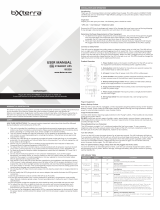
10
Buttons (Front Panel)
Basic Operation
“ON/OFF/STANDBY” Button
• To turn the UPS ON: with the UPS plugged into a live AC wall outlet*,
press and hold the “ON/OFF/STANDBY” button for one second.**
Release the button. If utility power is absent, you can “cold-start” the
UPS (i.e., turn it ON and supply power for a limited time from its
batteries***) by pressing and holding the “ON/OFF/STANDBY” button for
one second.**
• To turn the UPS OFF: with the UPS ON and receiving utility power,
press and hold the “ON/OFF/STANDBY” button for one second.** Then,
unplug the UPS from the wall outlet. The UPS will be completely OFF.
* After you plug the UPS into a live AC outlet, the UPS (in ”Standby” mode) will
automatically charge its batteries, but will not supply power to its outlets until it is turned ON.
** The alarm will beep once briefly after the indicated interval has passed.
*** If fully charged.
“MUTE/TEST” Button
To Silence (or “Mute”) UPS Alarms: briefly press and release the MUTE/
TEST button.*
To Run a Self-Test: with your UPS plugged in and turned ON, press and
hold the MUTE/TEST button. Continue holding the button until the alarm
beeps several times and the UPS performs a self test. See “Results of a
Self-Test” below.
Note: You can leave connected equipment on during a self-test. Your UPS, however, will not
perform a self-test if the UPS is not turned on (see “ON/OFF/STANDBY” Button description).
CAUTION! Do not unplug your UPS to test its batteries. This will
remove safe electrical grounding and may introduce a damaging
surge into your network connections.
Results of a Self-Test: The test will last approximately 10 seconds as the
UPS switches to battery to test its load capacity and battery charge.
• If the “OUTPUT LOAD LEVEL” LED remains lit red and the alarm
continues to sound after the test, the UPS’s outlets are overloaded. To
clear the overload, unplug some of your equipment and run the self-test
repeatedly until the “OUTPUT LOAD LEVEL” LED is no longer lit red and
the alarm is no longer sounding.
CAUTION! Any overload that is not corrected by the user immediately
following a self-test may cause the UPS to shut down and cease
supplying output power in the event of a blackout or brownout.
• If the “BATTERY WARNING” LED remains lit and the alarm continues to
sound after the test, the UPS batteries need to be recharged or
replaced. Allow the UPS to recharge continuously for 12 hours and
repeat the self-test. If the LED remains lit, contact Tripp Lite for service.
If your UPS requires battery replacement, visit www.tripplite.com to
locate the specific Tripp Lite replacement battery for your UPS.
* Overload alarms and battery alarms only. If you need to silence the AC bypass alarm
(available on select models), move the “AC Bypass Alarm” switch to the “Disable” position.
The switch is located on the back panel.
14-12-044-932757.indb 10 12/16/2014 5:11:06 PM



















